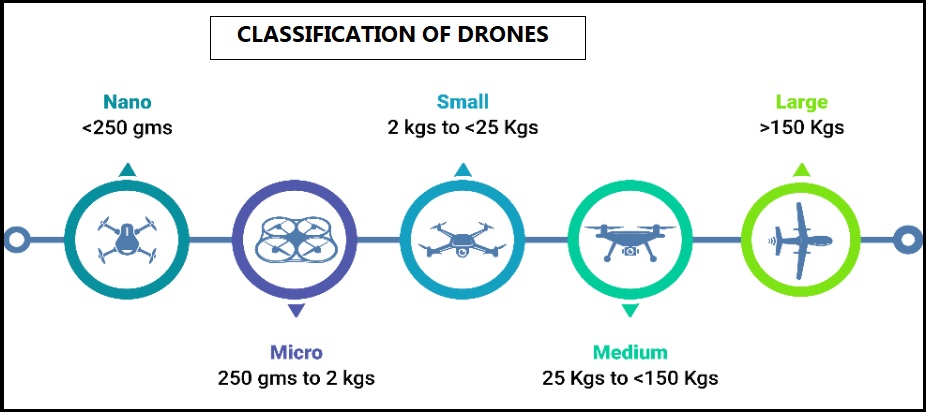Why in news?
Directorate General of Civil Aviation has recently published the final guidelines for operating drones by ordinary citizens.
What are drones?
- Directorate General of Civil Aviation (DGCA) is the civil aviation regulator in the country.
- As defined by DGCA, drones are remotely piloted aircraft (RPA).
- RPA is an unmanned aircraft piloted from a remote pilot station.
- The RPA, its associated remote pilot station(s), command and control links and any other components forms a Remotely Piloted Aircraft System (RPAS).
- The guidelines for operating them come into effect on December 1, 2018.
- It is the date from when civilian use of drones becomes legal in India.

What are the highlights?
- Drone types - DGCA has identified multiple categories of drones, broadly classified as:
- Nano (weighing up to 250 g)
- Micro (more than 250 g but less than 2 kg)
- Small and above (weighing 2 kg or more)
- Before flying - Every drone bigger than Nano must obtain a unique identification number (UIN) from the aviation regulator.
- This must be displayed on the aircraft, similar to the registration number of vehicles.
- A UIN will be issued once, against a fee of Rs 1,000.
- It will not be issued to a foreign citizen or entity.
- Users of bigger drones will be required to obtain a Unique Air Operator’s Permit (UAOP).
- This is similar to a driver’s licence for normal vehicles.
- The permit will cost Rs 25,000 and will be valid for five years, and renewals will cost Rs 10,000.
- The UIN and UAOP can be obtained from the online platform Digital Sky that will go live on December 1.
- The permits will reportedly be issued in less than a week.
- Flying conditions - All drones, other than the Nano ones, must meet mandatory equipment requirements.
- These include GPS, anti-collision light, ID plate, radio-frequency identification (RFID) and SIM facilities.
- Software that ensures ‘no-permission, no-takeoff’, among other features, is must.
- Before flying a Small or bigger drone, an operator has to file a flight plan, and inform the local police.
- This is for the machine to reach a height of 400 ft or more, and use both controlled and uncontrolled airspace.
- Micro drones will be required to submit a flight plan only if using controlled airspace.
- The operator must, however, inform the local police in all cases.
- Many drones used for amateur photography fall in this category.
- These aircraft will need a UIN but no UAOP, and will be allowed to climb only to a height of 200 ft.
- Nano drones will be able to operate freely, without any registration or permit.
- But their operations will be restricted to 50 ft above the ground.
- It is also limited to uncontrolled airspaces and enclosed premises.
- Training - All those requiring a UAOP must undertake a five-day training programme.
- This will expose them to regulations, basic principles of flight, and air traffic control procedures.
- They will also be taught on weather and meteorology, emergency identification and handling, etc.
- These operators will also have to take written tests and flight simulator tests before they are issued permits.
- Time - All categories of drones must be flown in the visual line of sight, and only during daytime.
- But photography using drones is allowed in well-lit enclosed premises.
- It would still be mandatory to inform the local police before flying.
- No-fly zones - DGCA has listed 12 categories of “no-drone zones”.
- These include the area up to 5 km from the perimeters of the high-traffic airports of Mumbai, Delhi, Chennai, Kolkata, Bengaluru and Hyderabad.
- For other airports, the no-drone zone extends up to 3 km.
- Drones cannot fly closer than 25 km of international borders, including the Line of Control and Line of Actual Control.
- The area within a 5-km radius of New Delhi’s Vijay Chowk is a no-drone zone.
- This, however, is subject to any additional conditions/restrictions of local law enforcement agencies/authorities for security reasons.
- The Ministry of Home Affairs can notify the perimeter of strategic locations and vital installations.
- A drone cannot be flown within 2 km from the perimeter of such areas, unless cleared by the Ministry.
- A drone can also not be flown
- within a 3 km radius of secretariat complexes in state capitals
- from a mobile platform such as a moving vehicle, ship or aircraft
Source: Indian Express